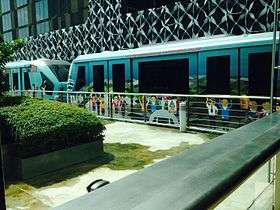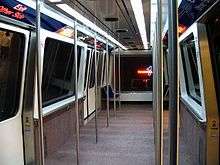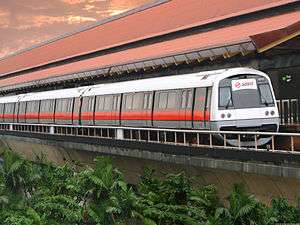Changi Airport Skytrain
| Changi Airport Skytrain | ||||||||||||||||||||||||||||||||||||||||||||||||||||||
|---|---|---|---|---|---|---|---|---|---|---|---|---|---|---|---|---|---|---|---|---|---|---|---|---|---|---|---|---|---|---|---|---|---|---|---|---|---|---|---|---|---|---|---|---|---|---|---|---|---|---|---|---|---|---|
 Changi Airport SkyTrain with special exterior design as part of SG50 celebrations. | ||||||||||||||||||||||||||||||||||||||||||||||||||||||
| Overview | ||||||||||||||||||||||||||||||||||||||||||||||||||||||
| Type | People mover | |||||||||||||||||||||||||||||||||||||||||||||||||||||
| Status | Operational | |||||||||||||||||||||||||||||||||||||||||||||||||||||
| Locale | Singapore Changi Airport serving Singapore | |||||||||||||||||||||||||||||||||||||||||||||||||||||
| Stations | 7 | |||||||||||||||||||||||||||||||||||||||||||||||||||||
| Services | 5 | |||||||||||||||||||||||||||||||||||||||||||||||||||||
| Operation | ||||||||||||||||||||||||||||||||||||||||||||||||||||||
| Opened | 1990 | |||||||||||||||||||||||||||||||||||||||||||||||||||||
| Owner | Civil Aviation Authority of Singapore | |||||||||||||||||||||||||||||||||||||||||||||||||||||
| Operator(s) | Civil Aviation Authority of Singapore | |||||||||||||||||||||||||||||||||||||||||||||||||||||
| Rolling stock | Mitsubishi Heavy Industries Crystal Mover | |||||||||||||||||||||||||||||||||||||||||||||||||||||
| Technical | ||||||||||||||||||||||||||||||||||||||||||||||||||||||
| Line length | 6.4 km (4.0 mi) | |||||||||||||||||||||||||||||||||||||||||||||||||||||
| Track gauge | 1850 mm Broad Gauge | |||||||||||||||||||||||||||||||||||||||||||||||||||||
| Electrification | 750 V DC Third rail | |||||||||||||||||||||||||||||||||||||||||||||||||||||
| ||||||||||||||||||||||||||||||||||||||||||||||||||||||
The Changi Airport Skytrain is an automated people mover that connects Terminals 1, 2 and 3 at Singapore Changi Airport. Opened in 1990, it was the first driverless and automated system in Asia.[1] The Changi Airport Skytrain operates from 0500 to 0230 daily and operates at 1 to 2-minute intervals.[2] Travel on the Skytrain is free and an inter-terminal journey takes about 90 seconds. All stations have platform screen doors, are air conditioned and have plasma displays indicating the arrival time of the next train.
With the opening of the Changi Airport MRT Station on 8 February 2002, the Skytrain is able to connect passengers at Terminal 1 to the MRT station entrances located at Terminals 2 and 3.[3]
Stations
| Station | Terminal | Destination Station | Service |
|---|---|---|---|
| A | Terminal 3 | A South | Transit |
| F | Transit | ||
| A South | Terminal 3 | A | Transit |
| B | Terminal 3 | C | Public/Transit |
| C | Terminal 1 | B | Public/Transit |
| D | Terminal 1 | E | Public/Transit |
| E | Terminal 2 | D | Public/Transit |
| F | Terminal 2 | A | Transit |
Rolling Stock

Trains operating on the Changi Airport Skytrain is the Mitsubishi Crystal Mover manufactured by MHI.
Initially, the Skytrain rolling stock consisted of Adtranz C-100s, jointly built by Westinghouse and Adtranz (acquired by Bombardier). In 2002, work began on a new S$135 million Mitsubishi Crystal Mover-based system to accommodate the planned opening of Changi Airport Terminal 3 and the projected increase in demand as the airport expands.[4]

The previous rolling stock of Adtranz C-100 ran without a second carriage per train (as opposed to the current Mitsubishi Crystal Movers, which runs with two carriages per train), and the first two platform screen doors of each station were for emergency purposes (The C-100s stopped at the outer half of each station, with two doors on each half.).
The third rail, formerly at the centre of the track, was moved to the side. The new system opened in March 2006 between Terminals 1 and 2 and opened the connection with Terminal 3 in November 2007 during Terminal 3's open house.
When it is Crystal Mover train like today, the Platform screen doors have glass windows to let to know when the train comes compared to the past which is small window or no glass window like Elevator Windows which is similar to Miami Airport Skytrain Concourse E.
Mitsubishi Heavy Industries Crystal Mover
| Mitsubishi Heavy Industries Crystal Mover | |
|---|---|
| In service | March 2006–present |
| Manufacturer | Mitsubishi Heavy Industries |
| Family name | Crystal Mover |
| Replaced | Adtranz C-100 |
| Constructed |
2002–2006 2016 - 2019 (Expansion) |
| Entered service | 2006 |
| Number under construction | 6 vehicles (6 trainsets) |
| Number built | 22 vehicles (22 trainsets) |
| Number in service | 16 vehicles (16 trainsets) |
| Formation |
1 per trainset M |
| Fleet numbers | 01 ~ 22 |
| Capacity | 8 seated, 107 standing |
| Operator(s) | Civil Aviation Authority of Singapore |
| Depot(s) | Terminal 1 Depot |
| Line(s) served | Changi Airport Skytrain |
| Specifications | |
| Car body construction | Welded aluminium |
| Car length | 11.84 m |
| Width | 2.8 m |
| Height | 2.0 m |
| Doors | 4 per car |
| Maximum speed |
60 km/h (37 mph) (design) 50 km/h (31 mph) (service) |
| Weight | 15,000 kg (33,000 lb) per car |
| Traction system | Mitsubishi IGBT-VVVF inverter vector control |
| Traction motors | Three phase AC induction motor 80 kW (110 hp) |
| Power output | 160 kW (210 hp) |
| Acceleration | 1.0 m/s2 (3.3 ft/s2) |
| Deceleration |
1.0 m/s2 (3.3 ft/s2) (service) 1.3 m/s2 (4.3 ft/s2) (emergency) |
| Electric system(s) | 750 V DC third rail |
| Braking system(s) | Electric command pneumatic brake with regenerative brake with stand-by brake and parking brake (with variable load control and wheel slide prevention control) |
| Safety system(s) | ATC, ATP and ATO |
| Coupling system | Bergische Stahl Industrie |
| Track gauge | Side-mounted guideway with rubber tires |
As of 2016 the Changi Airport Skytrain uses the Mitsubishi Heavy Industries Crystal Mover automated people mover. This rolling stock entered service in 2006 and replaced the 16-year-old Adtranz C-100, bringing this rolling stock of the second generation APM in Changi Airport.
Exterior design
The design of the train was black on top with grey on the bottom. The headlights were at the side with bigger headlights, compared to the ones operating on Sengkang LRT Line ans Punggol LRT Line, the headlights were small and at the bottom of the train. They placed Changi Logo at the side of each trains. They placed the fleet number ag the middle part of the train.
Interior design
The color of the interior is light-yellow. LCD screens (?) are placed at the end of every car, similar to the never-used LCD screens on the Mitsubishi Heavy Industries Crystal Mover C810. Unlike trains run under LRT, which have seating in the middle, it does not have seating in the middle and only at the end of each train. This is to allow more standing and more luggage space, also when the train is getting crowded. The trains boarded depends on which area one is in, for example, if you are in the Public Area, the seat color is blue (Set 01–10), while the Transit Area provides an orange color scheme on the seats (Set 11–16).
Train Formation
The configuration of a Mitubishi Crystal Mover in revenue service is M in single car mode and M-M is dual car mode
| Cars of Mitubishi Crystal Mover | ||||||||||
|---|---|---|---|---|---|---|---|---|---|---|
| car type | Motor | Collector Shoe | car length | |||||||
| mm | ft in | |||||||||
| M | ✓ | ✓ | 41 ft 2.1 in | |||||||
Redevelopment works
In 2015, a part of the Changi Airport Skytrain system connecting Station B and E will be suspended due to construction works for the upcoming Jewel Changi Airport. Passengers in the public area will have to use the mezzazine level bridge along Changi Airport MRT station, and the skytrain operating between Station A and F in the transit area.[5]
Future expansion
Plans are in place for possible future expansions of the system. To increase the system capacity of the Skytrain, six new train cars have been purchased and will be rolled out to the system by 2019. The existing shuttle between Terminals 2 and 3 will be upgraded to a three-car system, whereas the shuttle between Terminal 3 and 3 South will be upgraded to a two-car system.[6]
References
- ↑ "Singapore Changi Airport I, II, III". CPG Corporation.
- ↑ "Inter-terminal Transfer". Changi Airport.
- ↑ "Changi International Airport". National Library Board. 2001.
- ↑ "Milestones of Changi Airport". Changi Airport.
- ↑ "Getting between Terminal 2 & Terminal 3".
- ↑ "Skytrain at Changi Airport to get systems upgrade, more cabins". Retrieved 2016-05-03.
| Wikimedia Commons has media related to Changi Airport Skytrain. |
